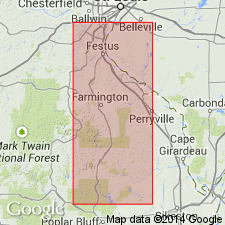
- Usage in publication:
-
- Butler Hill Granite
- AAPG geologic province:
-
- Midcontinent region
Summary:
Butler Hill Group, the older of two groups assigned to /St. Francois Mountains Volcanic Supergroup (revised). Includes (of J.R. Sides, 1976, IN E.B. Kisvarsanyi, ed., Missouri Geol. Survey, Rpt. Inv., no. 61, p. 105-113), in ascending order: Lake Killarney Formation, Grassy Mountain Ignimbrite, and Pilot Knob Felsite [units are here apparently formalized]. Study area is St. Francois Mountains, southeast Missouri (Midcontinent region). Older than /Taum Sauk Group (new) of St. Francois Mountains. Age is Precambrian Y. Nomenclature listed in table 1.
[Conflicts with nomenclature guidelines (ACSN, 1970; NACSN, 1983, 2005, 2021): name Butler Hill applied concurrently to two different units in same area; preempted by Butler Hill Granite of Tolman and Robertson (1969); name St. Francois Mountains applied concurrently to two different units in same area; a [supergroup] name combines a geographic name with the term ["supergroup,"] and no lithic designation is included; name Taum Sauk used for both group and formation within it (Taum Sauk Rhyolite has priority).]
Source: Modified from GNU records (USGS DDS-6; Denver GNULEX).
For more information, please contact Nancy Stamm, Geologic Names Committee Secretary.
Asterisk (*) indicates published by U.S. Geological Survey authors.
"No current usage" (†) implies that a name has been abandoned or has fallen into disuse. Former usage and, if known, replacement name given in parentheses ( ).
Slash (/) indicates name conflicts with nomenclatural guidelines (CSN, 1933; ACSN, 1961, 1970; NACSN, 1983, 2005, 2021). May be explained within brackets ([ ]).

